Scripture and Birds:
Learning from God's Creation
Text and photos by our friend, Don Burgess (except where noted)
![]()
Birds are mentioned more than 300 times in Scripture and some of Jesus' most memorable lessons used birds to illustrate them, such as
"Look at the birds in the sky; they do not sow and reap and store in barns, yet your heavenly Father feeds them. Are you not worth more than the birds?...How little faith you have!" (Mat. 6:26, 30).
The prophet Jeremiah also used the birds to illustrate truths. He said: "Even the stork in the sky knows her appointed seasons, and the dove, the swift and the thrush observe the time of their migration. But my people do not know the requirements of the Lord" (Jer. 8:7). So, we need to study the world that God created and do as the writer of Proverbs said to do:
"I applied my heart to what I observed, and learned a lesson from what I saw." (Proverbs 24:32).
1. Bravery—The Greater Kiskadee is only about five inches long, but when it is defending its young, it will take on a bird which is 40 inches from beak to tip of tail and has a wing-spread of 90 inches, the Man-O-War or Frigate bird. My wife and I watched a Kiskadee, whose young were up in a palm tree, fly out in attack any time a Man-O-War bird came near. The Man-O-War would duck and twist and go into all sorts of defensive maneuvers to get away. The Kiskadee always won.
Some birds will even take on a human. How can I forget the time in Arizona, about 25 years ago, when I was up on a ladder taking photos of some baby Great-horned Owls who were in a nest made between a couple of limbs of a Sahuaro Cactus. The mother silently swooped in from behind me and clawed my head as she flew by. She drew blood, and I got the point.
Psalm 22:14 says to "Wait patiently for the Lord, be brave and courageous. Yes, wait patiently for the Lord." We are told in this verse to be brave, but it is not a foolish bravery, it is combined with waiting patiently for the Lord.
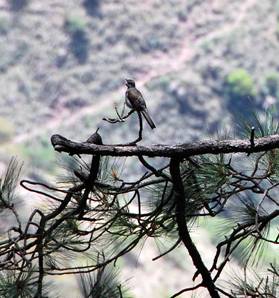
2. Real beauty—You can't judge the beauty that comes from within by someone's outward looks. The Brown-backed Solitaire is one of the world's most elegant singers, yet is just a dull brown bird. And the Elegant Trogan is one of the world's most beautifully colored birds (red, green and white), yet its song is more like a croak.
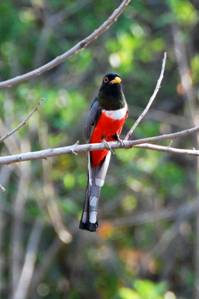
3. The Lord is my Shepherd--How else can we explain the migrations of birds apart from the fact that the Lord is their Shepherd. European Swifts are said to travel 3,000,000 miles in their lifetime. Tiny hummingbirds migrate thousands of miles and arrive at the exact same place as the year before. And even more amazing are the butterflies that arrive at the exact same spot after several years and several generations. Will not the One who shepherds the birds also shepherd us?
4. The artistry of God--As Peter Harris wrote in his book Under the Bright Wings: "Much of the beauty of the Woodlark's song, or the colors of a Bee-eaters plumage, goes well beyond what might be seen as necessary for the bird's biological effectiveness, and speaks of the artistic activity of a creator working to a different set of priorities than what is merely useful or efficient (p. 36-Vancouver, British Columbia: Regent College Publishing, 1993).
Something similar can be said about the different songs and calls that a single species might have. It seems to me that we can't always figure out a rational motive, like a mating call, etc. Maybe there are times when it's like singing in the shower--a time when inhibitions can be put aside and the bird just bursts forth. We need a few of those times ourselves.
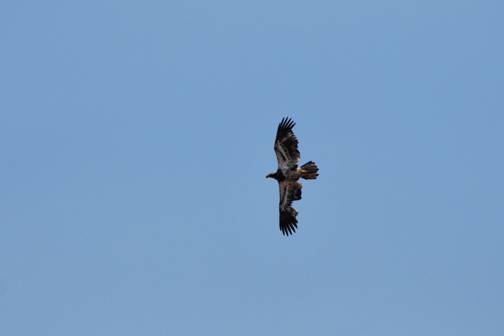
5. Warnings against danger--Birds will warn each other of danger. Several times while watching birds at High Island, Texas, the birds suddenly became quiet or suddenly flew away, and within seconds we saw an Osprey or a hawk, swooping low over the ground. In the Christian life, what is it that warns us and alerts us of danger and perhaps tells us to flee? It must be the Spirit of God using the Word. "Flee youthful lusts" the Word says and we better do just that, when the Spirit convicts us of that danger. We are told to walk circumspectly, to know what is going on around us.
Even the hawks must be careful. We saw a Swainson's Hawk with a big chunk out of its wing feathers, as if an alligator had taken a "chomp" when the hawk had swooped down to eat a bird sitting on the bank.
6. Contrary winds--We are like the birds that fly across the Gulf of Mexico from Yucatan to High Island, Texas. Not only are the birds tired after 16-20 hours of continual flying, if there is any kind of a wind blowing against them, they drop from exhaustion at the first land they reach. If the wind is behind them, they can fly on into the interior.
When a contrary wind hits us humans, usually unexpected, we barely make it to a safe place, if at all, and fall exhausted to the ground, just like the birds. Birders call this "fall-out". We call it "meltdown". When we do run up against a contrary wind in life, which is inevitable, we need to learn from it. And one thing we can learn from it is to cry out to the Creator for help.
I would hesitate to call the Spirit of God a contrary wind,
but he could be if we are going against him. We can go a whole lot further in
life if we go with the Spirit of God, not against him. We pay a steep price if
we are mulish and contrary.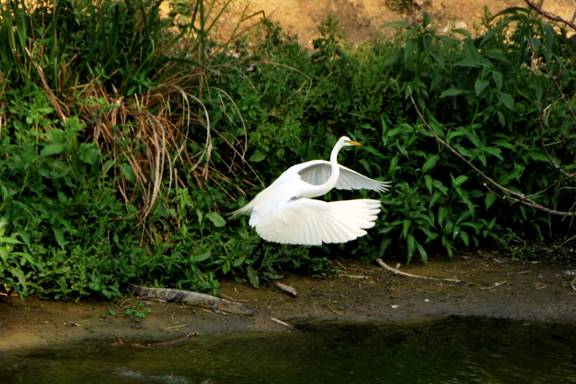
7. That which can save you can also kill you--The Rookery at High Island is a couple of small manmade islands surrounded by water. And in the water are alligators. The alligators keep the raccoons and coyotes and other creatures away that might eat bird eggs and birds. But the alligators are interested in the birds as well. You can watch an alligator slowly swimming towards a bird feeding on the bank, or an alligator might be stretched out on the shore with its mouth open waiting for some unsuspecting and careless bird to come by.
We were amazed at how close Tri-colored Egrets and Common Moorhens and Black-necked Stilts would get to the alligators—almost oblivious to their presence. I heard birders actually talk to the birds, anxiously telling them not to get so close to an alligator. And I am told that birders at High Island have seen alligators eat birds.
Let's relate that to Christianity. For one thing, we need others to warn us not to get to close to danger. Another is that Jesus is our Savior, but he is also our judge—He can send you to hell.
One other thought on this subject. This year, the warm winds that helped the birds fly across the Gulf ran into cold air coming off the Rocky Mountains causing a huge storm system with more than 150 tornadoes, killing over 40 people. Here again, that which can help you can also kill you. I wonder: How do birds handle a tornado? And how do we handle the really bad storms of life?
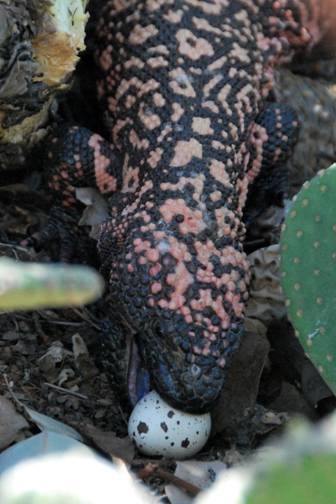
8. Sin and evil-- A Man-O-War bird spends most of its life out over the ocean, and can swoop down and pick food off the surface of the water, yet if it ever falls into the water, it will drown. Let's relate this to the world and the flesh (the Scriptures sometimes relate the ocean to evil). We live in the world, and the flesh is always with us, but if we "fall into the world and the flesh" we are in trouble.
Not too long ago we were up in Arizona where we watched a Gila Monster eating the eggs of a Gambel's Quail. And I have seen roadrunners eat baby birds, and a bull snake going into the nest of a Cactus Wren, even though the nest was in the middle of a Cholla Cactus, which is one of the most spiny plants of all creation.
This should remind us that there many forces in the world seeking to rob us of our children, both natural and spiritual. We must constantly be on the alert.
9. Our body--home of the Holy Spirit—Birds spend a great deal of time making a nest. Should we not spend time working on the nest, the home of the Holy Spirit, that is our body? It is not so much a physical task as it is a spiritual task. Notice that there are no cookie-cutter nests. Each bird species makes a special kind of nest, and each one is different according to the materials available.
One of the most unusual nests is made by the Orange-fronted
Parakeet in Central Mexico. It digs a hole out of a large termite nest which is
high in a tree. I suppose the termites provide a midnight snack for the birds.
(In the below photo, note the green parakeet on the lower branch.)
One way we keep our spiritual nest in good shape is to learn from other Christians, but too often we try to do exactly as they do. God does not need a bunch of clones. He needs Spirit-filled minds that can adapt to each new situation.
10. Variety--Variety is the spice of life. Each bird is so very different, which is why we never tire of birding. Birds teach us about the inexhaustible creativeness of the Creator.
11. Riding the turbulence—The Scriptures relate the air and wind to the Spirit of God. Thus we need to pay attention to what is going on in the air. In the first place we need to note that we cannot live without air and that birds would not be able to fly were it not for the air.
Then there is something called lift. Pelicans, for example, make use of lift, gliding just inches above the water. Webster's New Collegiate Dictionary defines lift as "the component of the total aerodynamic force acting on an airplane or airfoil that is perpendicular to the relative wind and that for an airplane constitutes the upward force that opposes the pull of gravity". We have to live in the world but the Spirit makes it possible to live above the level of the world and to not get pulled into it.
Then there is turbulence. Birds that fly in formation, such as cranes, pelicans and ducks are making use of turbulence. Pilots tell me that there is a spiral type of turbulence that comes off the tip of the wing of a plane or a bird, and that a bird can fly right on top of the spiral, nullifying the effect of gravity.
However, if a bird, instead of riding on top of the turbulence gets down in it, the turbulence could possibly flip it over. The energy saved by riding the turbulence allows the birds to fly more than 50% further (some say 70%). In a formation one bird is flying on top of the turbulence created by the bird in front. Only the first bird has to fly without this benefit, and the birds will switch when the leader gets tired. (At first I thought that the birds were using drafting, which Webster defines "to drive close behind another car while racing at high speed in order to take advantage of the reduced air pressure created by the leading car", to make their flight easier, but that does not seem to be the case.)
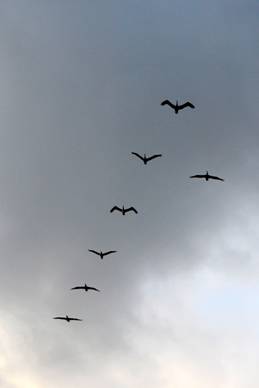
We humans do something similar to what birds do when flying in formation. We follow the examples of those who walk close to Jesus.
And there are people following us. Each of our experiences, especially the ones which cause turbulence in our lives, should help others to get through life in an easier and more understandable way. We are able to ride the turbulence, so to speak, of the person we are following, and others should be helped by ours.
If you are like me, however, you do not like others to see the turbulence in your life. We like to look good. But that might not be what the Spirit of God can use in the life of another. They might need to see how we stay on top of the turbulence and how we get out of it when we fall into it .
Once when a pilot friend was flying an ultra-light plane, he looked at his wing and just off the tip was a Snow Goose, going along with him and not even flapping its wings. How did it keep up with the plane? Our son who is a pilot in Africa explains to me:
"The bird is riding the bow wave. Air acts the same as water, it's called fluid dynamics. The same thing that enables a surfer to ride a wave on the sea, enables a bird to ride the wave of air produced when another wing, like that of an aircraft, disturbs the air. So the bird is 'going downhill' on the air current over the wing of the aircraft."
The air currents can be seen in the photo below of a crop duster in Mexico, taken by Johan Klassen.
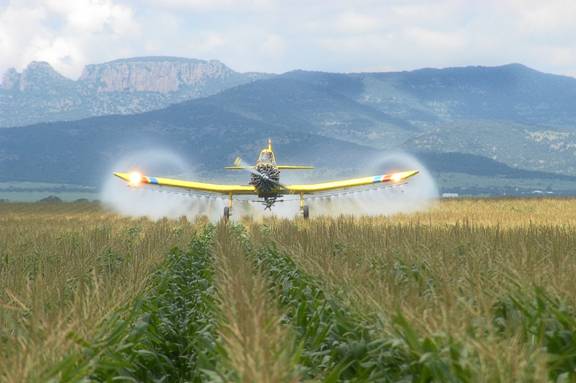
Once when I was on a ferry boat that goes from Guaymas, Sonora to La Paz, Baja California, about a seven hour trip, there were some gulls flying just above the heat coming from the ship's smokestacks, and they made the entire trip without flapping their wings. It is amazing that something we cannot see produces such results. Isn't that the way the Spirit of God works?
Another thing related to the air, that birds such as cranes and hawks make use of, are the rising warm currents of air. They use these to get up into the sky. Especially notable in this respect are the Eurasian Cranes that use these currents to get over the Himalayan Mountains. They do not always make it on the first try, or not at all, but they keep trying. This should certainly be a lesson for us. It is the Spirit that gets us over obstacles, and we might not make it the first time.
There is also something known as "drag" which according to Webster is "something that retards motion or action, the retarding force acting on a body (as an airplane) moving through a fluid (as air) parallel and opposite to the direction of motion...also retardation due to friction." The person we are following might be creating more drag in our lives than lift. We need to be discerning. As Paul wrote to the Corinthians:
"Be imitators of me, just as I also am of Christ." (I Cor. 11:1).
12. The groaning of the creation—Romans 8:22 says that "we know that the whole creation has been groaning as in the pains of childbirth right up to the present time." All we have to do to realize the truth of this is to 1) look at the destruction of wildlife habitat. 2) Watch the fighting that goes on in the mating season, and that goes on between birds over food. The Great-tailed Grackle in the photo below is trying to get the Snowy Egret to drop minnows it is catching, before it swallows them.
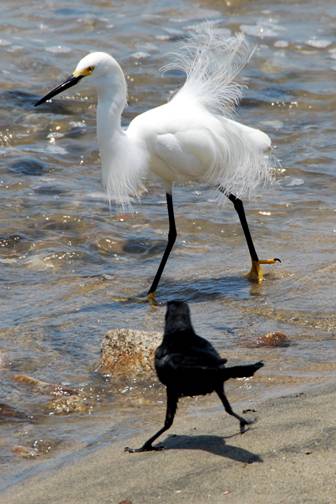
3) Look at a photograph of a pelican covered with oil from an oil spill. 4) Or read about an albatross that had in its stomach pieces of bottle tops, cigarette lighters, and hundreds of plastic bits which had been scooped up by the parents, regurgitated and fed to the baby (Audubon, March-April, 2010, p. 124).
But Romans 8 goes on to say that the "creation itself will be liberated from its bondage to decay and brought into the glorious freedom of the children of God." Thus the coming freedom of the birds (and all of nature) is closely tied to that of the children of God.
13. Naming of birds—Names are important in the Bible, many of which have specific meanings that relate to what is being taught. (Note the book of Ruth where the meaning of every name relates to the story.) Going back to Genesis, God told Adam to name the creatures, which he did. And I am wondering what criterion Adam used. Did he name the birds by colors, song, physical characteristics? To give them names he must have been well acquainted with them.
Looking at the Hebrew names for birds in the Old Testament can perhaps give us some ideas as to what criterion Adam used for naming them. The meaning of some of the bird names are unknown today. With others the scholars seem to be a little more sure of themselves. The following was gleaned from the book Flora and Fauna of the Bible (London: United Bible Societies (Helps for Translators, Vol. XI), 1972.):
The general word for bird of prey is possibly derived from a root which means 'to scream' or 'to shriek.'
The word for goose has a root meaning of 'white' . Sometimes it is translated as choice fowl (I Kings 4:23).
The word for rooster may be derived from a root meaning 'to look out,' watch, or hope for' because of its announcing the coming of the day. (Prov. 30:28-31)
The word for cormorant denotes the 'hurling down' of the bird upon its prey, illustrating its habit of diving into deep water after its prey (Lev. 11:13-17).
The word sometimes translated Long-eared Owl perhaps comes from the root 'to blow', as a hint to the sound uttered by the owls, or from a root meaning, 'twilight', the time when these birds appear (Is. 34:11)
There is a word translated screech owl or night-jar, a bird which was believed to be a female night-demon, which goes back to Babylonian legends. She was said to live in the deserts from which she attacked human beings. Another of the owl names could mean "violence" and suggests a predatory bird (Is. 34:14-15)..
The word for Ostrich is connected by some with an Arabic word meaning 'desert', or Aramaic word for 'greed'. Another word for Ostrich has the root meaning of 'to give a ringing cry', and thus an allusion to the hoarse complaining cry uttered by the bird at night (Job 39:13-18).
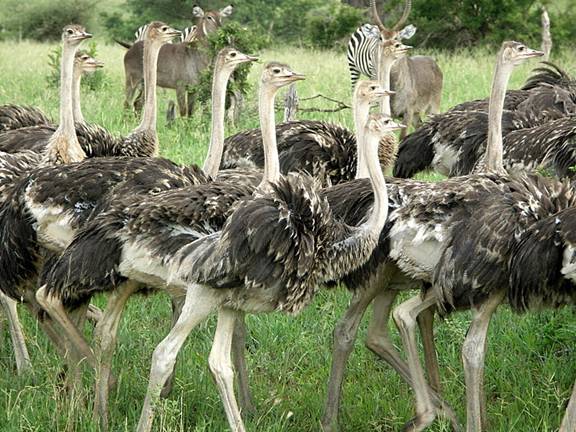
The word for Partridge literally means 'the caller', alluding to the peculiar call the bird makes when frightened (I Sam. 26:20; Jer. 17:11).
The word for Pelican is perhaps from the root "to throw out", thus a 'vomiter', which alludes to its alleged habit of throwing up food for its young from its crop. The translation of this word is doubtful and is sometimes rendered owl, etc. (Is. 34:11, 15).
The word for bittern perhaps comes from the root 'to roll up', referring to its bunched-up neck feathers. This word might also refer to the Bustard which has a bunched-up neck that swells in some species into a ruff in the breeding season. This word is also used for the porcupine (Is. 34:11--KJV).
The root for the word for sea gull or tern suggests the meaning 'thin' or 'lean', and this, of course, is a good description of the common tern (Deut. 14:15).
The root for sparrow has the meaning 'to cheep or to whistle". The word is used for 'bird' in general, thus you have to see the context to know what is meant (Ps. 84:3).
The word for stork perhaps is from a root which means 'goodness, kindness', because it was considered to be affectionate to its young, in contrast to the ostrich (Jer. 8:7).
The word for vulture or eagle was used for different birds of prey (Ex. 19:4).
Finally, it can be noted that in the Law of Moses the bat (a mammal) is listed among the unclean birds. Perhaps it was unclean since some species of bats eat blood, which was forbidden to the Israelites (Deut. 14:11-18). This listing of bats with birds would suggest that the definition of a bird in Hebrew was simply "a creature with wings."
We can see from the above that some names came from colors, others from the song or cry of the bird, some are from physical characteristics, or from how the bird acts or where it lives, or from folklore.
This is my Father's world.
The birds His glory sing.
The heavens ring
with the sounds of spring.
God is the Ruler yet.
14. All for the glory of God--The ultimate purpose of birds is the same as that of the heavens in Psalm 19. It is to proclaim (literally gush forth) the glory of God. Blessed is he who, when he sees the intricacy and beauty of a bird, stands in awe of the One who created it.
"Are not two sparrows sold for a copper coin?
And not one of them falls to the ground apart from your Father’s will."
Matthew 10:29
Devotional Messages | Bible Studies | Preparing for Victory